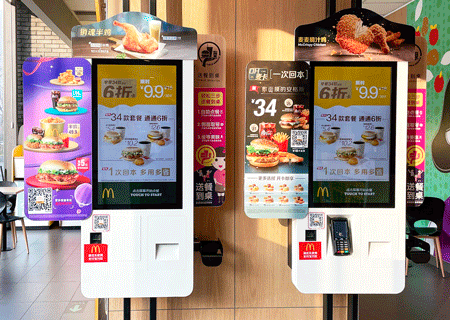I work at a McDonald’s but don’t get paid
I work at a McDonald’s but don’t get paid!
Self-serve kiosks, self-checkout, and other sorts of automation aren’t doing anything for customer service or satisfaction. Center director Jeffrey Cole explains.
By Jeffrey Cole
It used to be easy. You went to the counter, ordered a drink or a snack, the cashier announced the total, you handed them cash or a credit card, and then waited for your change or signed for it. During the pandemic, it got even easier when the signature for most charges became unnecessary. You held your phone near the credit card machine, it beeped, you said thank you, and went on your way.
This process had become more and more streamlined over decades, culminating in the most efficient checkout possible short of telepathy. Now we are headed far in the other direction, taking more time and effort, and slowing the whole process down.
The process is making us go to work.

Self-service ordering stations, like this one in China, are a growing global phenomenon. .Photo by WindMemories.
Last week, driving home from a conference in Las Vegas, I stopped at a McDonald’s in Primm, Nevada to buy a drink (and, of course, use the restroom). I went to the counter to buy a small drink. But I could not buy from the counter. It is closed. No one at the Primm McDonald’s provides any kind of service.
I had to go to a self-service machine.
Buying a drink meant moving through at least six screens. It’s only that simple if you are already familiar with the McDonald’s kiosk, enter everything perfectly, and do not have to go back or start over. During the screen journey, you must pause, go find an available table (each one has a number), trot back to the kiosk, and then enter the table number so a human can deliver your drink.
But there is still a long process you have to finish at the kiosk. You have to hope that your table is still available when you’re finally done. It’s easy to imagine two of more customers heading to the same table.
McDonald’s is making me work for them. I have to learn the process, doing for them what they have done for me and billions of customers for generations. Learning the process so that I can easily navigate through the screens takes at least five times longer than the old way.
And I just came in for a drink!
This is not the complaint of an old guy, whining about those new-fangled machines that are too difficult to learn. They are not difficult — just time-consuming and unforgiving of mistakes. If you’re ordering for a family or group, it’s even more time consuming. It’s also much more likely that you’ll make a mistake than if you were talking with a human. With the old way, a live person worked for McDonald’s, which paid the human to navigate the process.
The Golden Arches is not paying me.
Self-service is not an issue solely for McDonald’s; many stores are experimenting with self-service. The technology is a lethal threat to millions of jobs, but self-service doesn’t always work out. Some stores are removing self-service because of customer complaints and the risk of theft. Far more common is the hybrid model, where the customer has the choice of self-service or a live cashier… and it will probably take a little longer to get to the human.
The McDonald’s in Primm was the first I had been in where there was no choice. I had to go to work for McDonald’s or leave. If McDonald’s had offered me a discount (my “salary”) for working for them at the self-service kiosk, I might not have been as frustrated.
It’s not just McDonald’s
Worse than McDonald’s is the iPad “homework assignment.” When I’m buying something at a coffee shop, bagel joint, or mini market, often the person tapping in the order turns the iPad toward me; this is my signal that it’s time to go to work (with no salary or benefits).
I must answer questions, enter information, and then I get the opportunity to tip. I have to deliberate about whether to tip (and how much) while standing in front of the person seeking the tip. On some machines, math explaining how much to tip starts at 20% and goes as high as 40%. Almost everywhere, it takes several more screens to avoid tipping than it does to tip.
This is not a column about tipflation—the drastic increases in the expected amount of tips and the kinds of people expecting a tip. Recently, I ordered a car part online. At checkout, I was asked if I wanted to tip “for the team”… whoever and wherever they are.
Technology should make life and transactions easier. COVID accelerated the move to cashlessness. In the early days of the pandemic, we were afraid that cash carried the virus, and merchants didn’t want to interact face to face. Credit cards have moved from the wallet to the smartphone (as have boarding passes, metro, and other tickets). All states are in the process of issuing digital identification (several already do).
Our photo albums moved to our phones long ago. Credit cards and ID are following. Soon there will be no need for wallets. Digital technology can streamline almost all processes. Until now, the greatest fear was that facial recognition and location tracking, while efficient, might destroy our privacy or lead to great harm in the wrong hands.
Many stores are experimenting with self-service. The technology is a lethal threat to millions of jobs, but self-service doesn’t always work out. Some stores are removing self-service because of customer complaints and the risk of theft. Far more common is the hybrid model, where the customer has the choice of self-service or a live cashier… and it will probably take a little longer to get to the human.
Over the last few years, as we were making predictions for how digital technology would change the world, never did I or anyone else foresee that we would all become employees of fast food restaurants and retail stores. Corporations have sacrificed our convenience for their profit margins, and we took on the work of checking out with our purchases.
A couple of years ago, it was a novelty to find a self-service checkout at a warehouse store or restaurant. It was fun to navigate the payment process.
That novelty has worn off. I don’t want to be deputized as an employee at McDonald’s or Starbucks. And it doesn’t make the process more efficient. It slows it down. Customers have questions or needs that do not fit squarely into a box on the screen. As they seek human input, the whole line screeches to a stop.
Back at the Primm McDonald’s, I managed to stop an employee delivering food to the table (that’s still a human job, for now: the robots are coming). I politely asked him to let management know that, if this is their new policy, then it is my policy to stop coming to their restaurant. Not surprisingly, he could not have been less interested. Maybe if we all speak up firmly but politely, we can see the hybrid model retained.
Perhaps this giant step back is just a phase in the evolution of purchasing. We can already see the arrival of telling an avatar, who looks like a human, what we want for lunch.
At least then I will be doing what I always have done (ordering by voice) and do not have to become an unpaid employee of McDonald’s.
____________

Jeffrey Cole is the founder and director of The Center for the Digital Future at USC Annenberg.
See all columns from the center.
April 17. 2024

